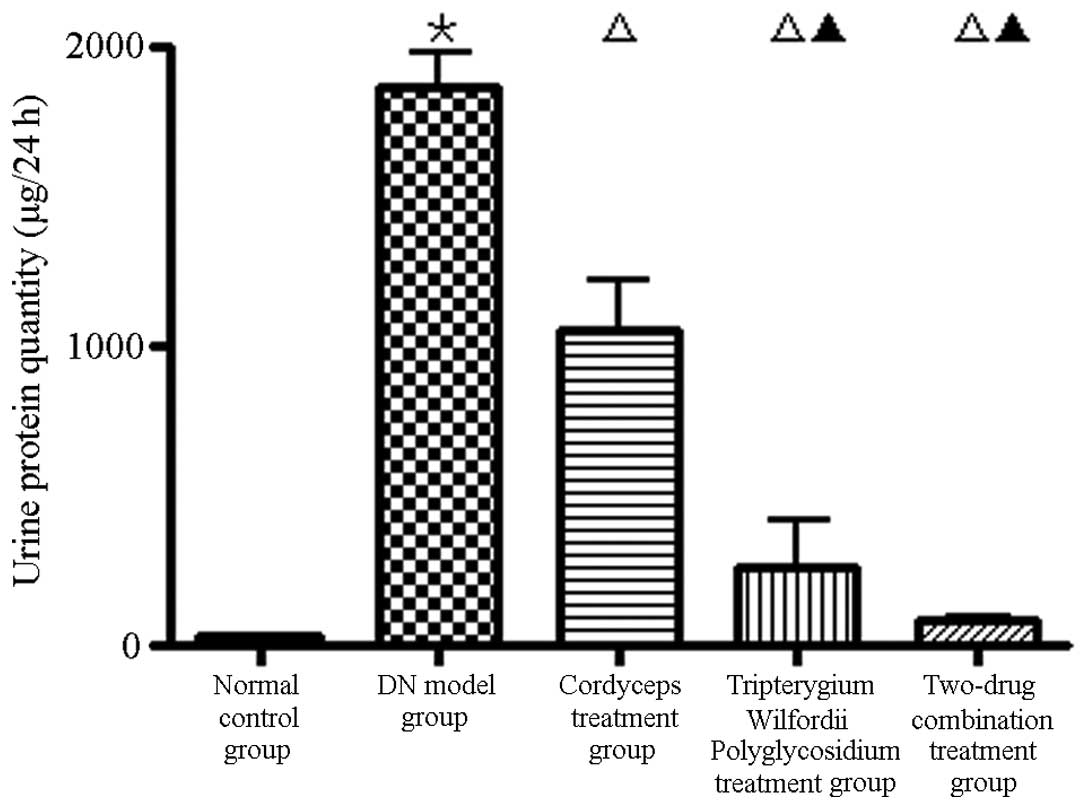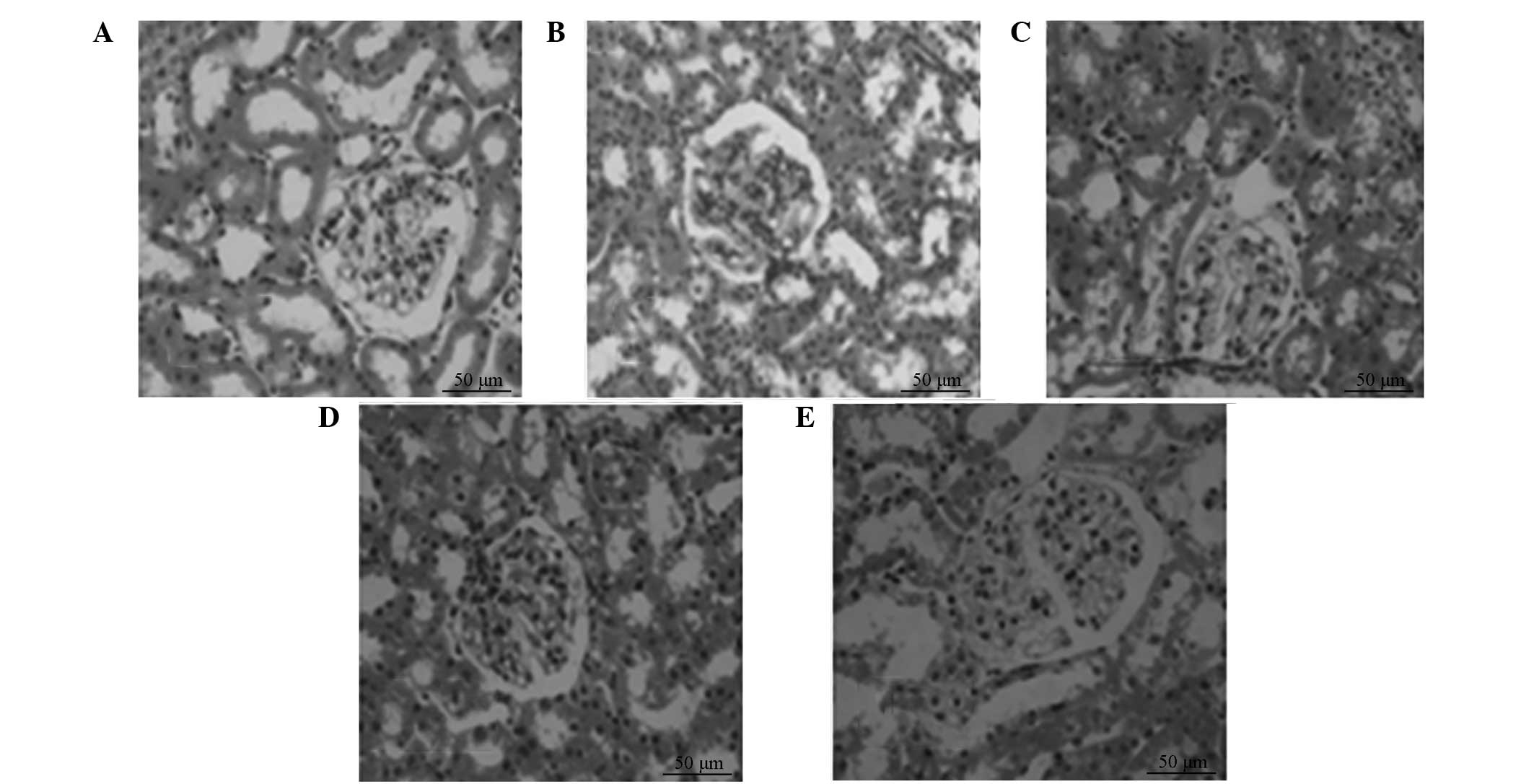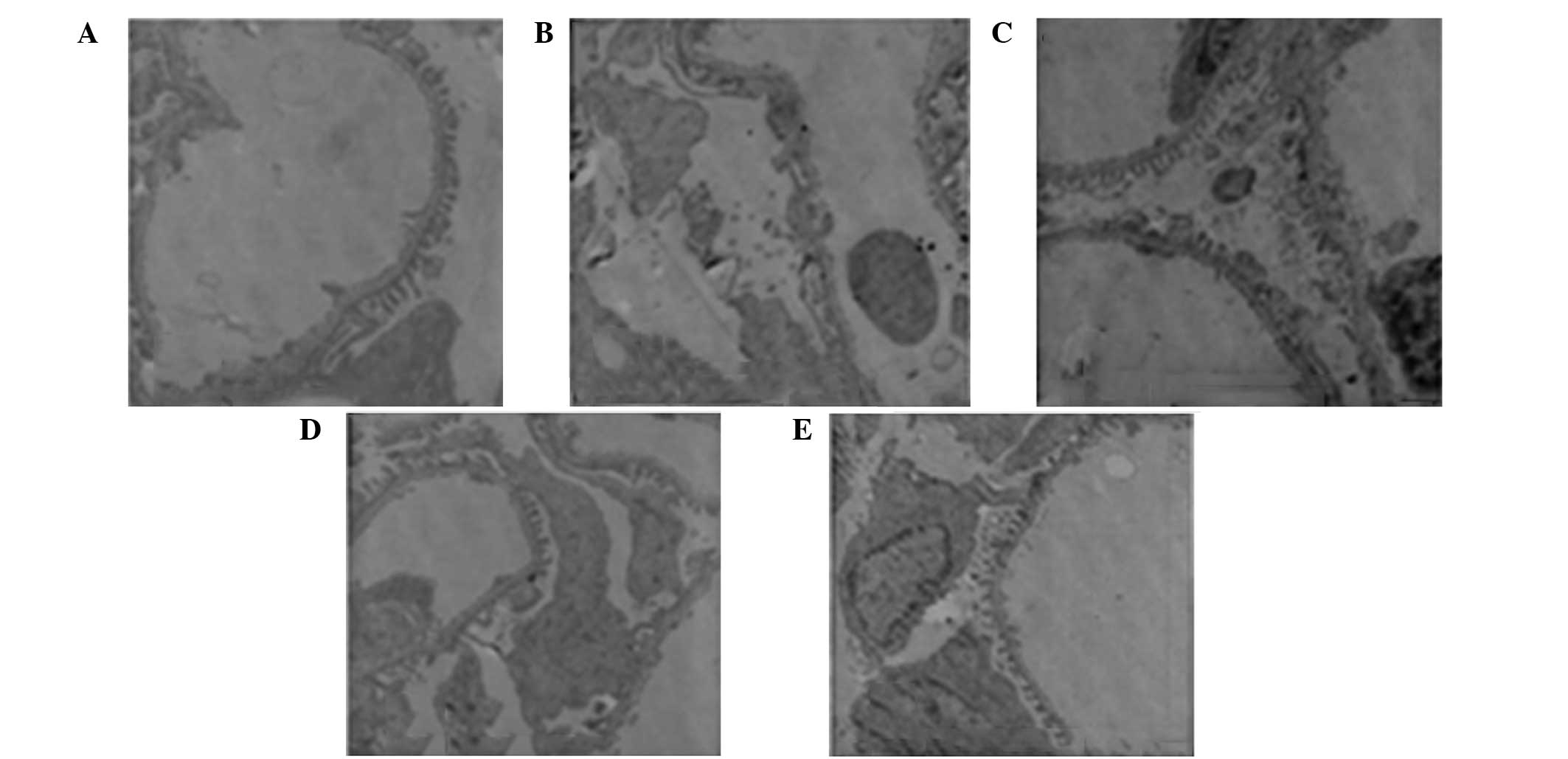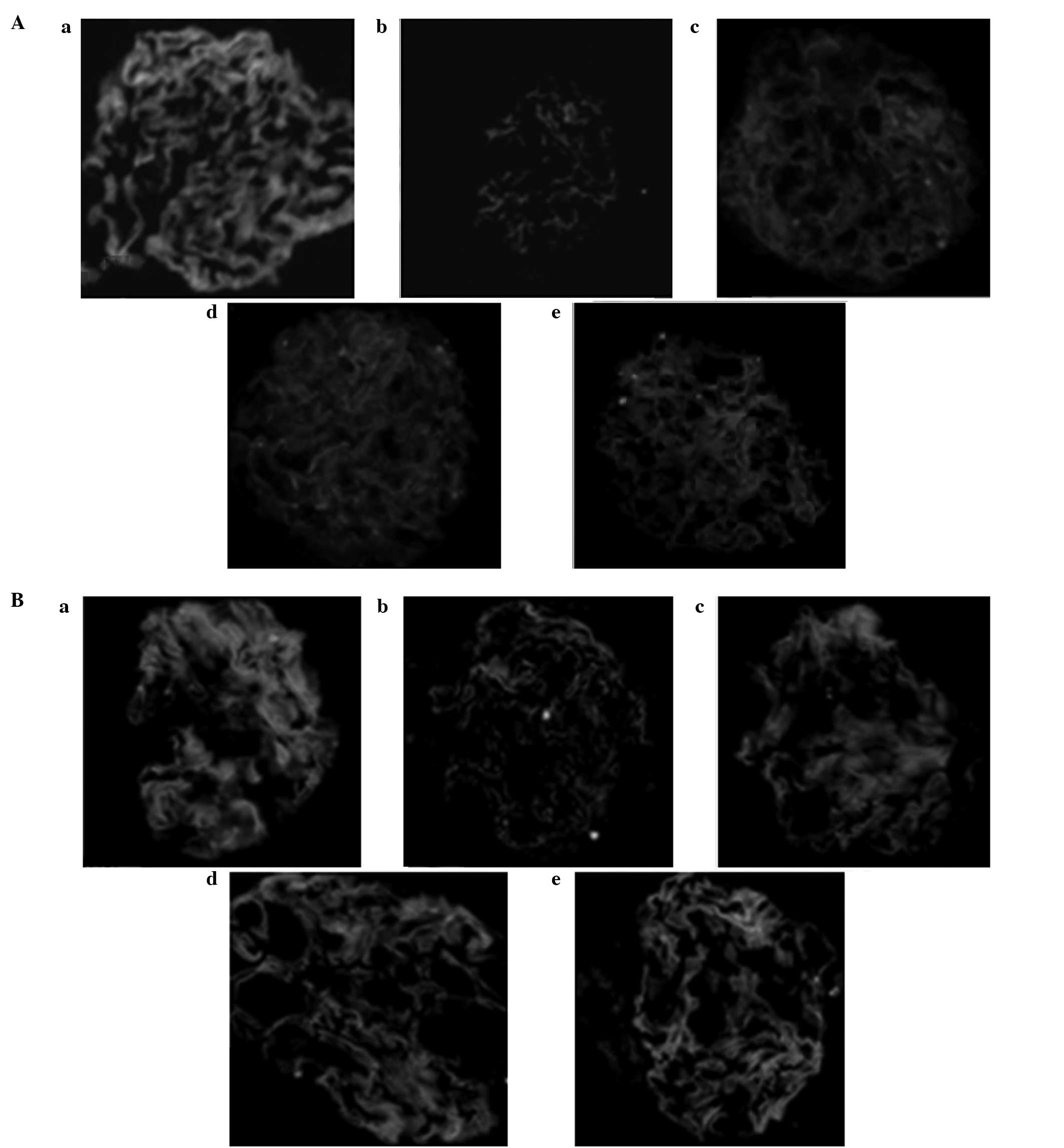|
1
|
Luimula P, Ahola H, Wang SX, et al:
Nephrin in experimental glomerular disease. Kidney Int.
58:1461–1468. 2000. View Article : Google Scholar
|
|
2
|
Furness PN, Hall LL, Shaw JA and Pringle
JH: Glomerular expression of nephrin is decreased in acquired human
nephritic syndrome. Nephrol Dial Transplant. 14:1234–1237. 1999.
View Article : Google Scholar : PubMed/NCBI
|
|
3
|
White KE and Bilous RW; Diabiopsies Study
Group. Structural alterations to the podocyte are related to
proteinuria in type 2 diabetic patients. Nephrol Dial Transplant.
19:1437–1440. 2004. View Article : Google Scholar : PubMed/NCBI
|
|
4
|
Hu Z, Li HP, Ye MQ, Yu HD and Zou GL:
Investigation advance in pharmacological activity of Cordyceps
sinensis. Anjisuan He Shengwu Ziyuan. 25:20–23. 2003.(In
Chinese).
|
|
5
|
Zhang XH, Shi LF and Hu JH: Research
progress of Cordyceps chemical constituents and pharmacological
functions. Zhong Yao Cai. 23:722–724. 2000.(In Chinese).
|
|
6
|
Lin RQ, Cheng H and Zhan YP: The mechanism
and application of Cordyceps agents and the application in kidney
disease (I). Zhongguo Zhong Xi Yi Jie He Shen Bing Za Zhi.
10:924–926. 2009.(In Chinese).
|
|
7
|
Lin RQ, Cheng H and Zuo Z: The mechanism
and application of Cordyceps agents and the application in kidney
disease (II). Zhongguo Zhong Xi Yi Jie He Shen Bing Za Zhi.
10:1016–1018. 2009.(In Chinese).
|
|
8
|
Camussi G, Mariano F, Biancone L,
Montrucchio G and Vercellone A: Effect of cytokines on the
cytoskeleton of resident glomerular cells. Kidney Int Suppl.
39:S32–S36. 1993.PubMed/NCBI
|
|
9
|
Garg P, Verma R and Holzman LB: Slit
diaphragm junctional complex and regulation of the cytoskeleton.
Nephron Exp Nephrol. 106:e67–e72. 2007. View Article : Google Scholar : PubMed/NCBI
|
|
10
|
Ichimura K, Kurihara H and Sakai T: Actin
filament organization of foot processes in vertebrate glomerular
podocytes. Cell Tissue Res. 329:541–557. 2007. View Article : Google Scholar : PubMed/NCBI
|
|
11
|
Schlondorf J: Nephrin AKTs on actin: The
slit diaphragm-actin cytoskeleton signaling network expands. Kidney
Int. 73:524–526. 2008. View Article : Google Scholar : PubMed/NCBI
|
|
12
|
Doublier S, Ruotsalainen V, Salvidio G, et
al: Nephrin redistribution on podocytes is a potential mechanism
for proteinuria in patients with primay acquired nephrotic
syndrome. Am J Pathol. 158:1723–1731. 2001. View Article : Google Scholar : PubMed/NCBI
|
|
13
|
Chen ZH, Liu ZH, Hong YM, et al:
Triptolide ameliorates podocyte injury induced by the terminal
complement factor C5b-9 in vitro. Shen Zang Bing Yu Tou Xi Shen Yi
Zhi Za Zhi. 18:310–317. 2009.(In Chinese).
|
|
14
|
Qin WS and Liu ZH: The therapeutic
mechanism of Triptolide. Shen Zang Bing Yu Tou Xi Shen Yi Zhi Za
Zhi. 16:158–161. 2007.(In Chinese).
|
|
15
|
Huang S: Studies in animal models of
diabetes status and progress. Guangxi Medical Journal. 24:46–48.
2002.(In Chinese).
|
|
16
|
Benigni A, Coma D, Zoja C, et al: Targeted
deletion of angiotensin II type 1A receptor does not protect mice
from progressive nephropathy of overload proteinuria. J Am Soc
Nephrol. 15:2666–2674. 2004. View Article : Google Scholar : PubMed/NCBI
|
|
17
|
Morigi M, Buelli S, Angioletti S, et al:
In response to protein load podocytes reorganize cytoskeleton and
modulate endothelin-1 gene: implication for permselective
dysfunction of chronic nephropathies. Am J Pathol. 166:1309–1320.
2005. View Article : Google Scholar : PubMed/NCBI
|
|
18
|
Christensen EI and Neilson S: Structural
and functional features of protein handling in the kidney proximal
tubule. Semin Nephrol. 11:414–439. 1991.PubMed/NCBI
|
|
19
|
Zou Z, Chung B, Nguyen T, et al: Linking
receptor-mediated endocytosis and cell signaling: evidence for
regulated intramembrane proteolysis of megalin in proximal tubule.
J Biol Chem. 279:343102–34310. 2004.PubMed/NCBI
|
|
20
|
Koop K, Eikmans M, Baelde HJ, et al:
Expression of podocyte-associated molecules in acquired human
kidney diseases. J Am Soc Nephrol. 14:2063–2071. 2003. View Article : Google Scholar : PubMed/NCBI
|
|
21
|
Toyoda M, Najafian B, Kim Y, Caramori ML
and Mauer M: Podocyte detachment and reduced glomerular capillary
endothelial fenestration in human type 1 diabetic nephropathy.
Diabetes. 56:2155–2160. 2007. View Article : Google Scholar : PubMed/NCBI
|
|
22
|
Saleem MA, Ni L, Witherden I, Tryggvason
K, Ruotsalainen V, Mundel P and Mathieson PW: Co-localization of
nephrin, podocin, and the action cytoskeleton. Am J Pathol.
161:1459–1466. 2002. View Article : Google Scholar : PubMed/NCBI
|
|
23
|
Liu ZH, Li SJ, Chen C, Zeng C, Zhang B,
Zhou H and Li L: Glomerular podocyte lesion in patients with
diabetic nephropathy. Shen Zang Bing Yu Tou Xi Shen Yi Zhi Za Zhi.
12:144–148. 2003.
|
|
24
|
Barisoni L and Koppb BJ: Update in
podocyte biology: putting one’s best foot forward. Curr Opin
Nephrol Hypertens. 12:251–258. 2003.
|
|
25
|
Tryggvason K: Unraveling the mechanisms of
glomerular ultrafiltration: nephrin, a key component of the slit
diaphragm. J Am Soc Nephrol. 10:2440–2445. 1999.PubMed/NCBI
|
|
26
|
Shen XG and Shen HC: Research advancement
of diabetic nephropathy and podocytes injury. Urology and
nephrology FMS. 25:680–683. 2005.(In Chinese).
|
|
27
|
Benzing T: Signaling at the slit
diaphragm. J Am Soc Nephrol. 15:1382–1391. 2004. View Article : Google Scholar
|
|
28
|
Langham RG, Kelly DJ, Cox AJ, et al:
Proteinuria and the expression of the podocyte slit diaphragm
protein, nephrin, in diabetic nephropathy: effects of angiotensin
converting enzyme inhibition. Diabetologia. 45:1572–1576. 2002.
View Article : Google Scholar : PubMed/NCBI
|
|
29
|
Zheng Y, Hao Li, Pan MS and Ding N: Effect
of Triperygium wilfordii polyglucoside on the podocytes of
diabetic nephropathy rats. Zhonghua Shen Zang Bing Za Zhi.
27:288–292. 2011.(In Chinese).
|














